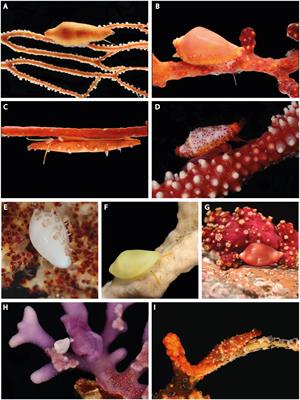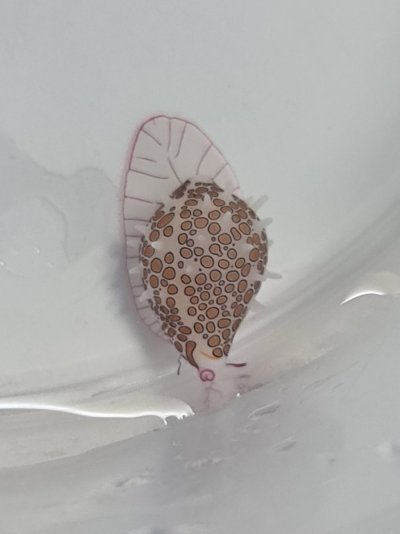Navigation
Install the app
How to install the app on iOS
Follow along with the video below to see how to install our site as a web app on your home screen.
Note: This feature may not be available in some browsers.
More options
You are using an out of date browser. It may not display this or other websites correctly.
You should upgrade or use an alternative browser.
You should upgrade or use an alternative browser.
Cowry like snail
- Thread starter Dutch_Mill
- Start date
- Tagged users None
@ISpeakForTheSeas? I wouldn't throw them away just yet in case they're harmless/beneficial
Edit: nevermind it turns out most cowrys eat coral
Edit: nevermind it turns out most cowrys eat coral
Looks like Diminovula margarita to me.
Margarita Cowries are not reef safe, they camoflage on corals to protect from predators, but eat soft corals. I would keep him in a sump or refugium with bits of softies and some form of light.
The appropriate punishment for GSP, xenia and Kenya trees.Margarita Cowries are not reef safe, they camoflage on corals to protect from predators, but eat soft corals. I would keep him in a sump or refugium with bits of softies and some form of light.
I think a small 10 gal tank full of pulsing xenia and Kenya trees with a few of these cowries to keep the population in check would be a pretty unique system
From the article...
"Ovulids are also called Allied cowries because each species tends to live with a specific host organism such as soft corals or sponges. Their adaptation to their host in form and colour is quite astonishing. They take on the shape, colour and texture of their hosts and usually it's hard to tell where one animal ends and the other begins. Only a close look will reveal the mollusk on its host. Each cowrie has a soft mantle that matches the color and texture of its host although there are notable exceptions. Some species have false polyps, some don't.
Gorgonians are generally unpalatable and are thus avoided by most predators. By closely resembling the gorgonian, the mollusk also gains protection from predators. Only the mollusk, however, benefits from this relationship.
Allied cowries are, in fact, parasites that harm their host. They feed on the host's tissues, mucus and polyps and absorb pigments that enable the cowries to closely match the host's color. The host continually regrows the lost tissue so the cowrie never runs out of food."
Likes like an allied cowry that lives symbiotically with the coral.
The coral didnt make it. It had a lot of damage and wouldnt expand anymore.
The appropriate punishment for GSP, xenia and Kenya trees.
I think a small 10 gal tank full of pulsing xenia and Kenya trees with a few of these cowries to keep the population in check would be a pretty unique system
Would they eat any soft coral but leave stone coral alone? I chucked in some star polyp eating Nudi's in my tank the other day to try and keep my star polyps in check. Think the wrasses got to them though as I havent seen them anymore. Would be nice if I can use these snails on star polyps.
You can try, but they'd also go after LPS and probably SPS based off of what I can findThe coral didnt make it. It had a lot of damage and wouldnt expand anymore.
Would they eat any soft coral but leave stone coral alone? I chucked in some star polyp eating Nudi's in my tank the other day to try and keep my star polyps in check. Think the wrasses got to them though as I havent seen them anymore. Would be nice if I can use these snails on star polyps.
I wish cowries were more well behaved and reef safe at full grown. So many gorgeous ones. Money cowries are really the only ones that are a fairly safe add.
I wish cowries were more well behaved and reef safe at full grown. So many gorgeous ones. Money cowries are really the only ones that are a fairly safe add.
As a kid, as a hobby I used to collect shells, and often hunted for cowries. The thing is, they were always to be found, hidden underneath rocks and dead coral pieces. This means they are not very good candidates for a display tank anyway. They will live out of sight underneath the aquascape and rarely come out, prehaps only at night.
The coral didnt make it. It had a lot of damage and wouldnt expand anymore.
Unfortunate. In the wild, obviously these allied cowries would not kill off the coral that they live in. However, in an aquarium, the balance is upset, and maybe one cowry could overcome and damage the coral to this point.
Yeah, either D. margarita or D. concinna - either way, they're coral parasites.Looks like Diminovula margarita to me.
They may or may not eat a wide range of soft corals, but they'll likely leave stony corals alone for the most part:Would they eat any soft coral but leave stone coral alone?
"Ovulidae (Fleming, 1828), is a family of specialized carnivorous caenogastropods that feed by browsing on octocorals (Anthozoa: Octocorallia: Malacalcyonacea and Scleralcyonacea) or, to a much lesser degree, on antipatharians (Anthozoa: Hexacorallia: Antipatharia) and Stylasteridae (Hydrozoa: Hydroidolina: Anthoathecata)."*
Basically, they feed on a bunch of soft corals (Octocorals - GSP, gorgonians, softies, etc.), and occasionally they'll feed on Black Corals (not kept in any hobbyist aquarium that I'm aware of at the moment) and athecate hydroid polyps. For reference, Litophyton is from the order Malacalcyonacea.
*Source:

Spicy food for the egg-cowries: the evolution of corallivory in the Ovulidae (Gastropoda: Cypraeoidea)
IntroductionHost-parasite associations provide very useful models to study adaptive processes. We investigated the interaction between carnivorous marine gastropods, the Ovulidae or egg-cowries, and their cnidarian food targets. Ovulidae (Fleming, 1828), is a family of specialized carnivorous...
Similar threads
- Replies
- 5
- Views
- 205
- Replies
- 13
- Views
- 414
- Replies
- 7
- Views
- 246


















